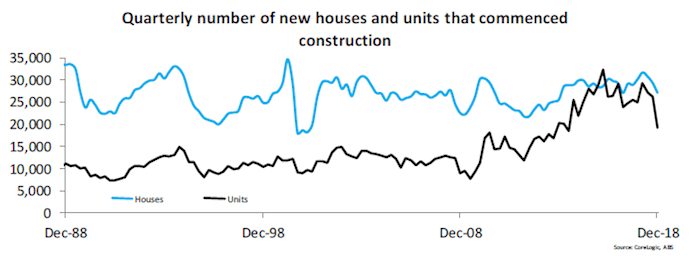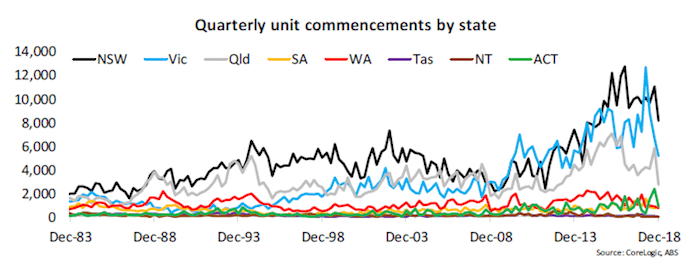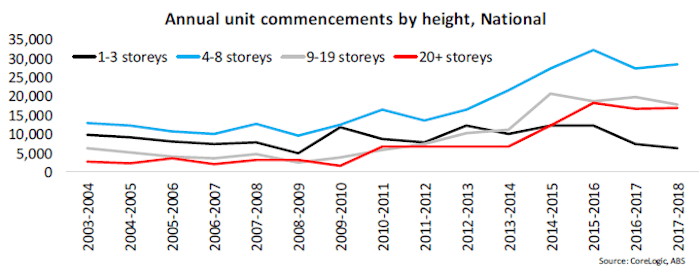The increasing prevalence of highrise construction: Cameron Kusher
The Australian Bureau of Statistics (ABS) recently released the quarterly building activity data for December 2018.
The release is a treasure-trove of data and includes information on dwelling commencements, dwelling completions, dwellings under construction and dwellings approved for construction but not commenced.
This release has published very valuable data on the number of units commenced by the number of storeys.
Click here to enlarge:

Source: CoreLogic, ABS
In terms of dwelling commencements, there was a significant slowdown over the quarter. In fact, house starts fell 7.6% over the quarter to their lowest level (27,088) since March 2017.
Unit commencements recorded a much larger -26.8% decline to 19,134 commencements, the fewest over a quarter since September 2013 and the largest quarterly decline in commencements since September 1974 when they fell -32.5%.
Despite the falls, both house and unit commencements remain above their long-term average.
Click here to enlarge:

Source: CoreLogic, ABS
The most notable change in the landscape of dwelling commencements over recent years has been the lift in apartment starts and more recently their fall.
The increase in higher density construction has primarily been driven by the three most populous states, or more specifically, the capital cities of each of those states.
Over the past five years, every state and territory has seen unit commencements reach historic high levels, demonstrating a clear shift towards higher density development (that isn’t to say that detached housing construction hasn’t also climbed significantly over the period).
More recently, as the housing market has turned and values have started to fall we can see there is a reduced preparedness of developers to commence new projects.
We would expect that commencements, particularly for units, are likely to continue to trend lower over the coming quarters as housing values continue to record value falls, finance remains tight, and both domestic and foreign investors remain light on the ground.
Click here to enlarge:

Source: CoreLogic, ABS
In the latest building activity release the ABS published a further breakdown of annual unit commencements by the height of the building.
While the number of commencements has climbed significantly over recent years, it is interesting to note that commencements of units in a one to three storey block has been relatively steady.
Anecdotally, the demand/supply ratio of medium density dwellings remains much healthier relative to high density products.
Conversely, there has been significant increases in commencements of taller buildings over recent years with commencements now beginning to ease.
This reflects both the unit construction boom and also the fact that as the cost of acquiring sites has increased developers have sought approvals for taller buildings in an effort to maximise their yield and to recoup acquisition costs and maximise profits.
With dwelling commencements expected to continue to fall, the decline doesn’t negate the fact that many developers have paid high prices to acquire sites.
As a result we would expect that despite an expectation of fewer commencements going forward, those projects that do commence will largely be taller apartment projects.
Notwithstanding that expectation, larger projects are generally riskier for the developer and achieving sufficient presales to commence a project is more of a challenge when there are more units to sell.
In order to maintain profitability of projects it is highly likely that as values continue to decline that dwelling commencements will continue to fall.
CAMERON KUSHER is the head of research for the Australian branch of CoreLogic
Kusher regularly posts on the CoreLogic website.
